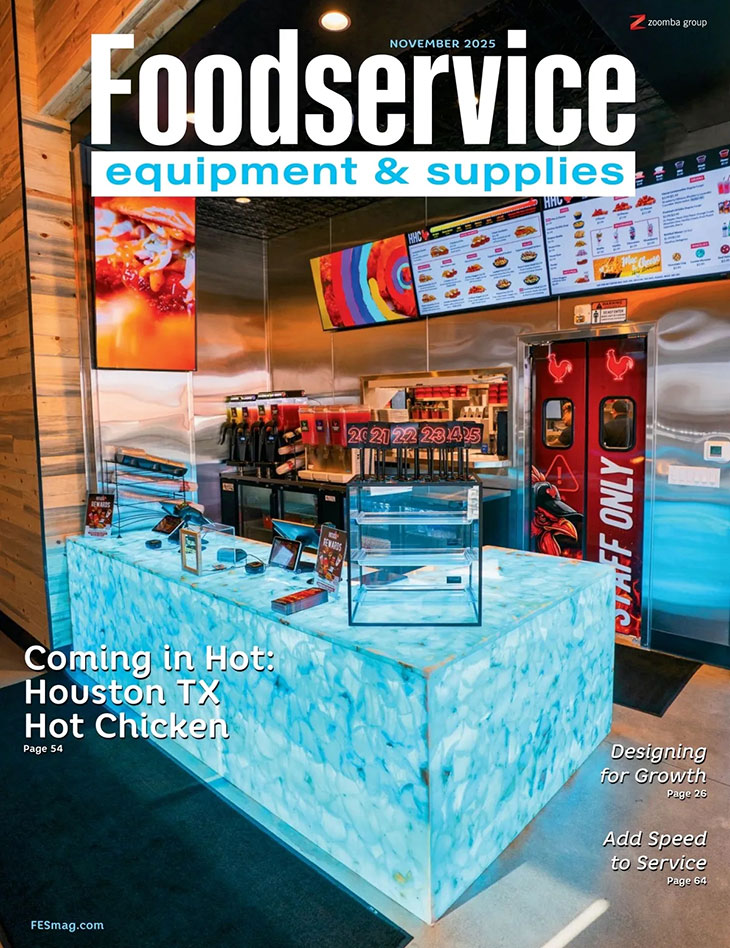In today’s workplace, it seems everyone is dealing with a talent shortage. In August 2018, the U.S. Bureau of Labor Statistics noted there were more than 7 million job openings. Over the past year, there has been a net gain in the number of jobs available. The prospects for an infusion of new talent remain low since it is currently a job hunter’s market.
 By Julie Jones, RDN Director of Nutrition Services (retired), The Ohio State University Wexner Medical CenterOne of the keys to success for all members of the foodservice industry, however, will be the ability to develop five-star talent from within. The concept of developing this talent supports the reality of today’s workplace with its evolving job requirements and changing needs — a workforce with lower average tenure in any one job and growing complexity in organizations with matrix management. Internal staff members will have a shorter learning curve in the ever-changing work landscape.
By Julie Jones, RDN Director of Nutrition Services (retired), The Ohio State University Wexner Medical CenterOne of the keys to success for all members of the foodservice industry, however, will be the ability to develop five-star talent from within. The concept of developing this talent supports the reality of today’s workplace with its evolving job requirements and changing needs — a workforce with lower average tenure in any one job and growing complexity in organizations with matrix management. Internal staff members will have a shorter learning curve in the ever-changing work landscape.
In their article “How Company Culture Shapes Employee Motivation” in Harvard Business Review, Lindsay McGregor and Neel Doshi note that company culture shapes employee motivation. Their research shows why we work influences how well we work. The three direct factors that influence employee motivation are play, purpose and potential. Cultivating internal talent can impact these factors and amplify growth potential for existing staff.
Since I am writing this during the heart of football season, coaching analogies are top of mind. Are there ways to assemble human resource (HR) operations much like a professional football team? The divisions could emulate those elements that contribute to winning teams: playbook, scouting, player development, and
coaching and feedback.
Playbook
The playbook sets the stage for performance by identifying the strategy and individual talents necessary for peak performance. As the coach, you craft the strategy with your team — what do we want to accomplish and how do we get there?
Frequently organizations operate from a robust strategic plan but do not have a talent plan to support it. It takes time to step away from daily work to view this more broadly. Being able to quantify the knowledge, skills, abilities and behaviors (KSAB) necessary to achieve the peak performance that your playbook defines pays big dividends. Sometimes, you might have to alter your strategy based on talent. In other words, good coaches understand the talent they have and develop strategies to get the most from it.
So how do you quantify KSAB for different roles? Understand the areas of expertise critical to your company’s success and what particular competencies might be most important. Competencies such as emotional intelligence, communication, feedback, motivation, decision making and critical thinking represent examples of how your team accomplishes its work. Aligning the work of the team, financial performance, operations knowledge and customer engagement represent examples of what the team needs to accomplish. What competencies does your business require to bring the strategies in your playbook to life?
Scouting
In a business sense, scouting centers on identifying potential in employees. Unfortunately, what often happens is that leaders use employees’ past success to predict future performance without consideration for those key skills that will drive desired outcomes. Other factors that can cloud identifying potential in staff members include overlooking broader competencies due to a focus on technical skills necessary for an individual position; being fooled by a resume and an accomplishments list that lacks the backing of how the work was completed; and lastly, understanding that each leader has a bias as to what true potential looks like.
The Center for Creative Leadership has studied potential and global leadership competencies for many years. Their research identifies adaptability, comfort with ambiguity, self-awareness, creativity, strategic thinking, collaboration and managing change as necessary for the new workplace. Being a learner and being curious are also key traits. Can you identify some of these skills in your existing staff? What skills would you consider on your “potential” list?
Two National Football League teams offer a stark contrast when it comes to identifying and developing talent. Take, for example, the New England Patriots. Despite having low draft choices, the team continues to develop many key contributors from within and remains one of the league’s elite teams. The exact opposite is the Cleveland Browns, who, despite having very high draft choices year after year, can’t seem to come up with a winning strategy for developing players, which consistently keeps them at the bottom of their division.
Player Development
Do you work with staff members on a joint development plan? How can you develop their best potential and identify what assignments will give them the intentional practice growth requires? At times, leaders defer these considerations to HR. When leaders take on the role of coach, however, they now drive these conversations and partner with their staff for mutual benefit. This shifts the ownership and evaluation for leaders from an approach focused heavily on business outcomes to one that also includes staff development. If you were evaluated on the success of your staff, how would you rate? Do you prioritize time in your schedule each day to develop and coach staff?
In their Harvard Business Review article “HR Goes Agile,” Peter Cappelli and Anna Tavis provide a backdrop of key changes developing staff require. One critical element is developing leaders as coaches. Companies continue to invest in coaching training since many view coaching as crucial for a managerial career. Think back: Have you ever received any training in coaching?
Merriam Webster offers a number of definitions for “coaching,” including:
- one who instructs or trains (noun)
- one who instructs players in the fundamentals of a sport and directs team strategy (noun)
- to train intensively as by instruction and demonstration (verb)
Note how the definition refers both to actions and individuals. In other words, as a coach, you have to identify and assess the current skills and potential of the individuals that comprise your current roster. How will you coach and train to position team members to help them address the missing key skills or gaps in their performance?
The coach should focus development to one or two critical performance areas. This focus will allow the coach to create intentional learning, which includes knowledge, practice, experiences, projects and feedback necessary for growth. The development plan would look different for each member of the team instead of applying a broad stroke for all. Actively engage the individual staff member in the process and guide them to seek learning opportunities to support their plan.
At the start and end of each season, it’s common for coaches and other team executives to meet with players individually to review their development, plan for the future and more as it relates to the bigger picture. This practice ensures both the team and its players remain on the proverbial same page about their expectations and performance.

Coaching and Feedback
After establishing a player development plan, the leader as coach creates learning opportunities and instructs, trains, demonstrates and provides feedback on learning and performance to create ongoing dialogue about development and performance. For the best development, coaching and feedback must be ongoing, which also eliminates any surprises once the season or shift ends.
Assessing performance and delivering feedback is a learned and practiced skill. Foundational competencies, such as emotional intelligence and trust, are essential for best performance, too. I teach a graduate course in managerial leadership at The Ohio State University, and more than 75 percent of the students want to learn how to deliver feedback more effectively. I’ve also heard this same feedback from new leaders through the years. The most common concerns I’ve heard with assessing performance and giving feedback include getting it right, pushback from employees and fear of conflict. Leaders need to remain open to feedback in developing this skill as well as handle these situations as if they were on the receiving end of the feedback. If you evaluated your performance from the receiving end, how would you rate?
Leaders have access to numerous resources to help develop better assessment and feedback skills. Jennifer Porter’s article in the Harvard Business Review titled “How To Give Feedback People Can Actually Use” offers specific suggestions you can apply.
Football performance reviews often take place on a weekly, or even daily, basis. During the season, for example, coaches will break down game film on a play-by-play basis with the team to applaud strong performances and highlight areas for improvement moving forward. Often, football teams will break down film in even greater detail by position groups. Think offense, defense and special teams. And college football coaches will often reward players’ performances by providing them with stickers they proudly display on their helmets.
What steps do you and your team take to break down game film, so to speak? What steps do you and your organization take to celebrate and reward outstanding performance on an ongoing basis?

Summary: The Ohio State University Wexner Medical Center
Many years ago, I developed a leadership philosophy to establish priorities for myself as a leader. A few of the principles on the list directly support employee development, including:
- Invest in people and develop them for broader roles.
- Focus on employee needs ahead of my own.
- Know that some employee conversations must be had, even if they are uncomfortable.
By establishing priorities, I made time for them in my schedule as well as for those on our team. We’re proud to say that more than 65 percent of leader and administrative support staff has been promoted from within Nutrition Services at The Ohio State Wexner Medical Center, while at the same time, we have made many positive contributions to our organization and profession. Internal talent development has become part of our culture.
A few years ago, I began considering retirement from Ohio State. I began to invest more time in preparing for this transition and having focused development conversations with our leadership team. I use a 2-by-2 principle, identifying two skills for development and two skills at which they “rock” — deliver outstanding performance.
It is important for staff to understand how they can contribute to the team and others’ success by amplifying their strengths. The 2-by-2 lists have become part of our monthly or bimonthly meeting conversations for development and feedback.
Not surprisingly, my replacement at Ohio State, Julie Meddles, has been promoted from within. The remaining leadership team is transitioning and sharing their own 2-by-2 feedback for her.
Getting better at identifying our strengths and development opportunities allows us to have more personal discussions about performance. In doing so, we can continue to support our organizations’ talent needs as well as our own goals for personal development.



